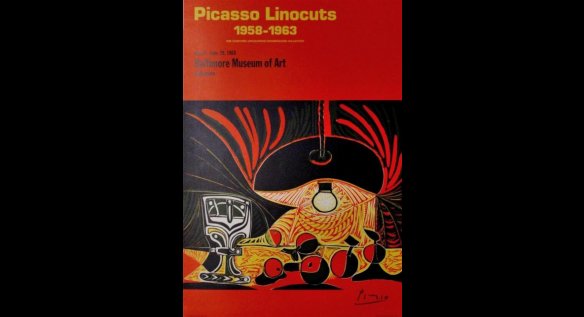Picasso Linocuts
| Artist | : | Pablo Picasso |
| Medium | : | Silkscreen |
| Size unframed | : | 20.00"/28.43" |
| Size framed | : | N/A |
| Signature Info | : | Hand Signed - By the artist |
| Frame Info | : | Yes |
| Condition | : | Very Good |
| Year | : | 1969 |
Description
This is a rare (c500) Hand Signed Print, by Pablo Picasso
Pablo Picasso (Spanish, 1881 - 1973). "Picasso Linocuts: 1958-1963 [Baltimore Museum of Art]". Color silkscreen. 1969. Signed in blue crayon, lower right. Edition of c500. Light cream wove paper. The full sheet. Fine impression. Very good condition. Literature/catalogue raisonne: Cf. Bloch 1101; Cf. Czwiklitzer 276(a) (1970 ed.); Cf. Czwiklitzer 329 (1981 ed.). Poster created (and exhibition held) during Picasso's lifetime, with Picasso authorizing its printing. A scarce poster; no auction records in the past 25 years located. Our present example of this poster is rare. The first exhibition by this name was held at The American Gallery, New York (The Computer Applications Incorporated Collection), April 1 to 30, 1968 (unrecorded by Czwiklitzer). It subsequently travelled to the Museum of Fine Arts, Boston (The Computer Applications Incorporated Collection) from January 28 to February 28, 1969 (Czwiklitzer 276(a), 1970 ed.). It then traveled to the Baltimore Museum of Art, Baltimore (The Computer Applications Incorporated Collection), May 6 to June 29, 1969 (unrecorded by Czwiklitzer). Its final stop appears to have been to The New York Cultural Center, New York (The Computer Applications Incorporated Collection), June 24 to September 20, 1970 (unrecorded by Czwiklitzer). All posters had the same Picasso linocut image, and all were printed by Triton Press, New York. Image copyright © Artists Rights Society (ARS), New York. Overall size: 28 7/16 x 20 in. (722 x 508 mm).
- Artist: Pablo Picasso
- Title: "Picasso Linocuts: 1958-1963 [Baltimore Museum of Art]"
- Medium: Silkscreen
- Year: 1969
- Edition: c500
- Size: 28 7/16 x 20 in. (722 x 508 mm).
- Signature: Hand signed by the artist
- Authenticity - Letter from Auctioneer attesting Authenticity
Pablo Picasso 1881-1973
School of Paris painter, sculptor, etcher, lithographer, ceramist and designer, who has had enormous influence on 20th century art and worked in an unprecedented variety of styles. Born at Malaga, Spain, son of an art teacher. His family moved to Barcelona, where he entered the School of Fine Arts 1895; then entered Madrid Academy 1897. Early showed great precocity. First visited Paris in autumn 1900, returned in 1901 when he had his first Paris one-man exhibition at the Galerie Vollard. Blue Period paintings of beggars and sad-faced women. Settled in Paris 1904. In 1905 painted some pictures of circus folk and embarked on his Rose Period. 'Les Demoiselles d'Avignon' 1906-7 marked the beginning of a more revolutionary manner, influenced by Cezanne and Negro art. Met Braque in 1907 and with his collaboration created Cubism. Designed sets and costumes for Parade and other Diaghilev ballets 1917-24. Made some neo-classic figure paintings 1920-4, parallel to later Cubism. Started to make more violently expressive and metamorphic works in 1925, and in the following years frequently exhibited with the Surrealists. Important series of wrought-iron constructions and modelled sculptures 1928-34, illustrations for Ovid's Les Métamorphoses, Buffon's Histoire Naturelle etc. Awarded First Prize at the 1930 Pittsburgh International. His painting 'Guernica' 1937 was inspired by the destruction by bombing of the Spanish town of that name. Continued to live in Paris throughout the Occupation. From 1946 lived mainly in the South of France at Antibes, Vallauris, Cannes, and from 1958 near Aix-en-Provence, where he maintained a prolific output of paintings, sculptures, etchings, lithographs and ceramics. Died at Mougins, near Cannes.
Published in:
Ronald Alley, Catalogue of the Tate Gallery's Collection of Modern Art other than Works by British Artists, Tate Gallery and Sotheby Parke-Bernet, London 1981, pp.591-2



